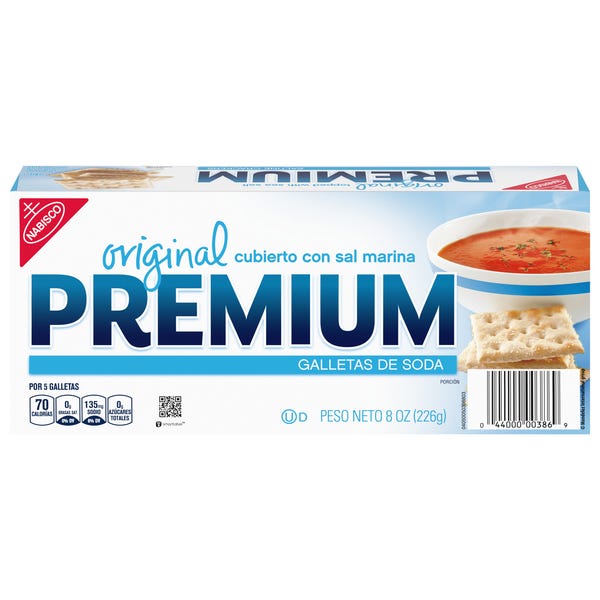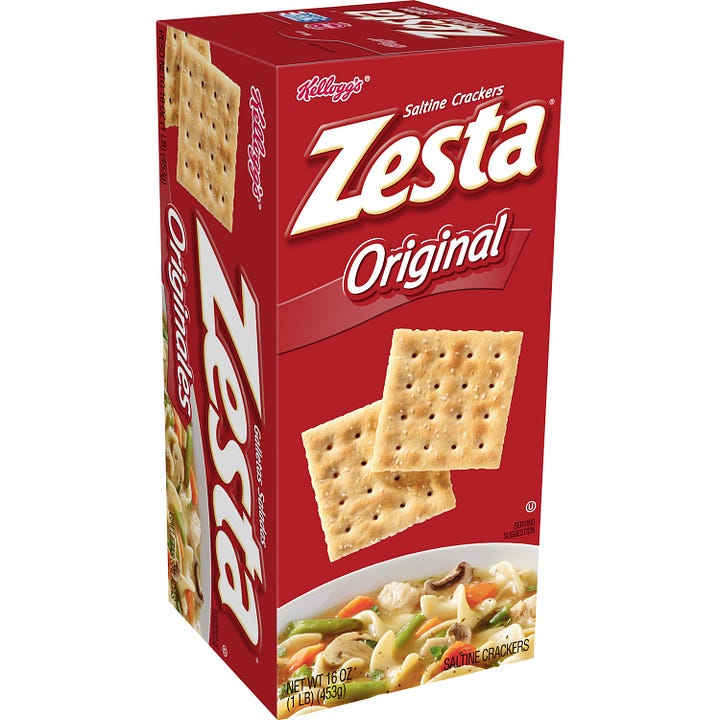When You Feed a Wolf Saltines
Why the saltine cracker has fed me & other Americans over generations
“Appetite, a universal wolf.”
—William Shakespeare, Troilus and Cressida
My mom says I get it from my grandfather. At seven years old, I reflexively grab another sleeve from the box of Nabisco Premium saltine crackers perched on the pantry shelf. I feel my tongue perk from the cracker’s coarse salt and soothe it with a swig of milk from a glass stretching taller than my shins.
This ritual snack was a means of comfort, an unconscious way to stay connected to my grandfather, who was born in the early 1930s. He ran Buckles Farms & Ranch in the Texas panhandle and snacked nightly on crumbled saltines in a mug of milk, always eaten with a spoon. I never knew him — he died 36 years before I was born — but through this daily bread, I feel I do.
Saltines’ origins stem from hardtack, the original MRE (meals ready to eat) for military members because it provided suitable sustenance with low spoilage. Hardtack consisted of only flour, water, and occasionally salt, poked with holes to ensure it remained flat, and then baked multiple times to eliminate the water and risk of mold. The result was a dense, dull, unleavened square that required ample preparation to eat: Soldiers would dunk it in water, coffee, or even mix it with condensed milk to soften its unyielding edges. It remained commonplace in the military up until World War I.
However, 1876 saw a new kind of cracker: With the addition of yeast and sodium bicarbonate, the light and airy saltine was born. The same perforations spotted its face, but this time with a dusting of crackly salt, giving its signature saline punch. The innovation was introduced by Frank L. Sommer of F.L. Sommer & Co at the Buchanan County Fair in St. Joseph, Missouri. After receiving the “premium blue ribbon” prize, Frank’s business and the cracker business as a whole began to boom, as many existing cracker companies (including F.L. Sommer & Co) merged to form the National Biscuit Company, aka Nabisco. While various large legacy brands now sell a saltine cracker, Nabisco furnishes its packaging with the Premium blue detailing to honor Frank and his prize-winning creation.
Since inception, the cracker has been a ubiquitous remedy for gastrointestinal upsets or ephemeral ailments. Expecting mothers are encouraged to chew a few before getting out of bed as a means of easing morning sickness because the sodium bicarbonate neutralizes sharp stomach acids. While still popular for such remedial reasons, saltines have taken many forms in American kitchens. During the Great Depression in particular, economizing on food led to unconventional creations where the cheap cracker functioned as a filler, in recipes such as cracker cakes, saltine cracker pie, and a diner tomato soup made with hot water, ketchup, and the free packs of saltines crushed up until they formed something coagulated enough to fool the wolf.
I chatted with my mom and her two siblings about my grandfather’s habit. My aunt noted that she was never a fan of those salty crackers, it mostly the men in the family who favored such a starchy brew. My uncle — who is a fabulous storyteller — painted a picture for me. In his words, he would walk into his father’s office with a saltine cracker and “daddy” (he referred to him) would ask, “How about a glass of milk?” It happened just like that. “When you see your parents do something and it’s not deadly or injures you,” my uncle explains, “It’s okay!”
The saltines and milk combination popularized as a meal during the Great Depression: Saltine crackers were generally one of the cheapest things in the grocery store and home refrigeration to preserve milk was uncommon until the end of the 1940s. “Recipes” drawn from the coupling of milk and saltines only exist now on Youtube or obscure online forums. They flood with users recounting their parents crushing the crackers in a bowl or glass of milk, and I can’t help but wonder if this is where the habit of eating cereal before bed grew its roots.
To understand why saltines endure in American pantries, I can’t overlook that familial-borne habits simply persist over time. If not deliberately then inadvertently for maintaining a sense of closeness, nostalgia, or comfort. I am exhibit A. Sharing space with another person makes it plain that I mimic my family’s food habits; it’s a process that results from sharing taste and space with them for 18 years. When I’m not eating saltines and milk before bed, I’m drinking herbal tea, the same thing I watched my mother do every night as a child (while I, yes, spilled milk and crumbs everywhere).
In the process of getting other perspectives on saltines and its enduring gastronomic relevance, I came across an article titled Depression, Saltines & I, beneath which username Maria responds, “Could my being drawn to the boxes of Saltines have come from a feeling of nostalgia, for home and its comforts …? Or from a desire for some sort of continuity – the cracker itself and packaging have hardly changed over the years – a comforting constant in these turbulent times.”




Maria has a point, as the saltine cracker packaging hasn’t changed much since its inception. For Nabisco, its original large and white rectangular tin stained with large navy letters reading “PREMIUM” remains very much the inspiration for its modern packaging. Keebler Zesta, another top seller of saltine crackers, also has packaging that to this day very closely mimics its early branding of the cracker.
The price, as with all prices, have risen over time but saltines still remain an affordable choice when compared with other consumer packaged snack goods. Whether from the consumer’s personal experience or overlaid by way of marketing tactics, nostalgia remains a signature marker for products like saltines. Food is emotional, and brands know that. It’s understandable then, if flavor, branding, and price continuity are the grounds, why saltines persist a reliable comfort amidst the world’s quickening pace of change.
Our emotional food choices as consumers are what continue to buoy legacy products like saltines because longing for “home and its comforts” will continue to whet Americans’ appetite for foods that represent such reminisces. In winter, this is especially true. “Saltine” as a Google search term has jumped 110% in popularity in the past 20 years, and it shows a significant spike every November/December, alongside other American comfort foods such as “mac and cheese,” “pot roast,” and “chili.” If our craving for comfort food spikes in the winter, so must our emotional aches associated with such food. Amid a season more arid, the wolf, I suppose, requires more than that which will only physically appease. When the chill sets in, both body and soul seek solace.
Why have saltines persisted in the American food canon? Whether it is from being habitual, affordable, versatile, emotional, or simply tasting good, saltines have maintained an identity as something Americans can rely on. For many, they are powerful vessels of nostalgia, unchanging among rapidly evolving food trends and tastes. In feast or famine, we are comforted by familiar flavors that remind us that our instincts are not wrong — that it is those proclivities, ultimately, that will draw us back to what will altogether satisfy us.
Thank you for being here. If you enjoyed this essay, please consider giving it a ♥️ or share with someone you love. Your support helps sustain my work.





